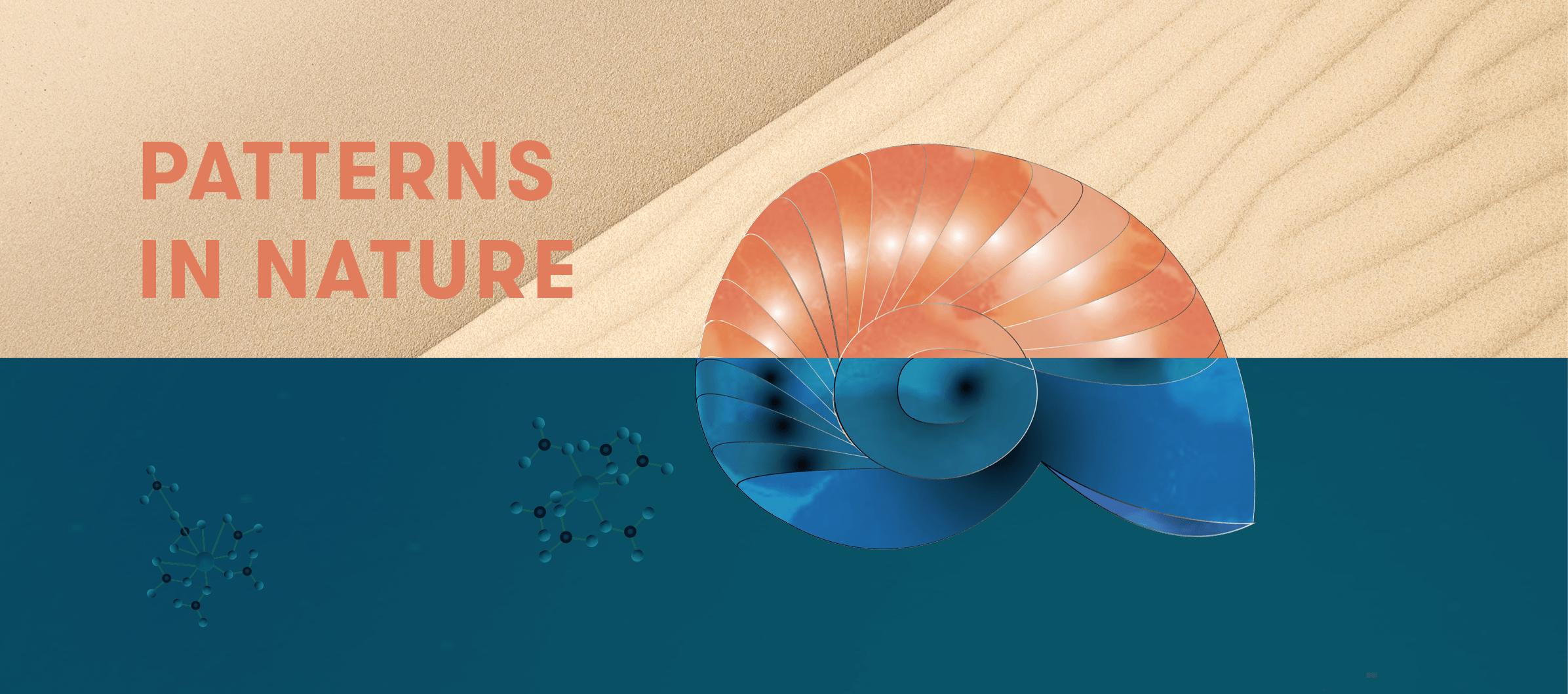She sells sea shells…
Expert reviewers
Essentials
- Shells are made of calcium carbonate, in the mineral form of calcite or aragonite.
- Animals build their shells by extracting the necessary ingredients—dissolved calcium and bicarbonate—from their environment.
- Shells come in many shapes and sizes, from giant clams more than a metre wide, to tiny shells that can barely be seen with a microscope.
- Most shells that you’ll find when you’re wandering along the beach are either bivalves (shells that have two parts connected together) or gastropods (the snail-type shells).
- The oldest known individual animal lived in a shell—a specimen of the shellfish Arctica islandica has been documented to be 507 years old.
One of my favourite souvenirs as a kid was a (scallop, I think) shell with googly eyes and fluffy hair glued onto it.
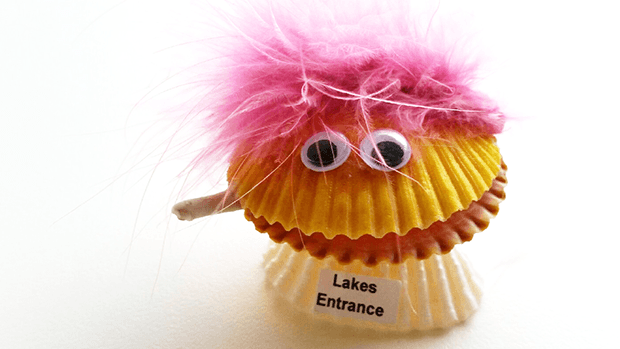
Most treasured keepsake ever. The shell itself was very pretty—the wonky eyes and fluffy hair didn’t really do much to improve its appearance. It had coloured stripes and clearly visible ridges along its surface. And when you looked closely, you could see even more intricate structures and textures. Pretty weird to think that such a complex and intricate structure is built by a blobby shellfish or snail that, technically, doesn’t even have a brain. So, how do they do it?
What is a shell made of?
They may look very different, but pretty much every shell you pick up on the beach is made of the same stuff: calcium carbonate (CaCO3), otherwise known as the mineral calcite. It’s actually the same mineral that stalactites and stalagmites that are found in caves are made of, although obviously the formation process is very different. Shells can also be made of the mineral aragonite, which has exactly the same chemical composition as calcite—CaCO3—but the atoms within the mineral are packed together in a different way, giving the mineral a different structure.
Interestingly, the mineral aragonite only forms geologically under conditions of high temperature and high pressure—it’s not geologically stable under normal conditions at Earth’s surface; it converts to calcite. Exactly how some shellfish manage to make this usually unstable form of calcium carbonate is still a mystery.
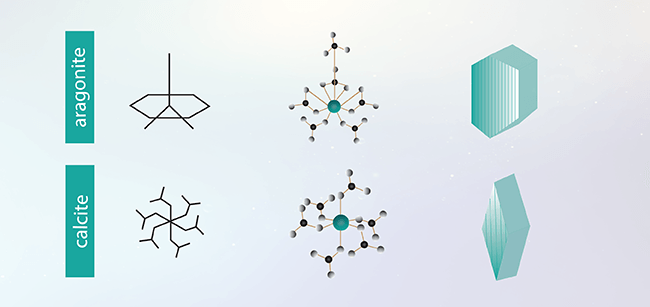
Many shells are actually made of both calcite and aragonite. Blue mussel (the ones you buy from the fish shop and find in your marinara sauce) shells grow simultaneously in two directions: the shell grows longer, with layers of calcite being added on at the growing edge, and it also thickens, adding layers of aragonite internally. This inner layer is known as nacre, or the nacreous layer, and it has a shiny, pearly appearance—think ‘mother of pearl’ shell. The shininess comes from the structure of the aragonite crystals—they form small plate-like structures that diffract light. The outer layer is called the prismatic layer, and generally has a duller appearance.
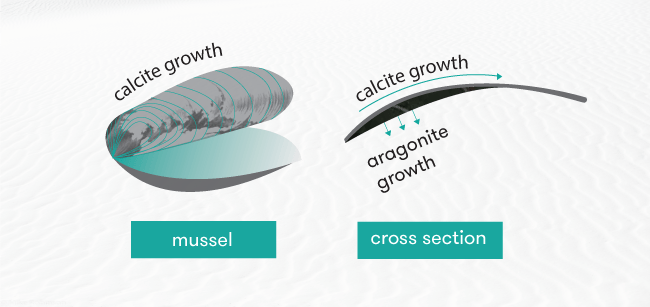
Another interesting feature is how shells can be repaired—sometimes an animal that grows a calcite shell actually uses aragonite to mend cracks or shell damage.
Mixed in with the calcium carbonate is a small amount of protein within the shell. This makes for a very strong, yet light material, which resists dissolution in water to provide protection to the soft, slimy and otherwise very vulnerable animal inside.
Covering the entire shell is an organic protein layer, called the periostracum. This is an organic layer that helps isolate the area in which active shell formation takes place, and provides the organic framework against which the calcium carbonate is laid down. It also helps protect the shell, giving it increased water resistance and durability. After an animal has been dead for a while, the periostracum is lost (often eaten by bacteria, or abraded away), exposing the calcium carbonate shell underneath.
How are shells built?
The process of shell creation is known as biomineralisation—bio for biological (because it’s an animal creating it) and mineralisation because it’s the mineral calcite, or aragonite, that’s being formed.
A typical shellfish or snail has a region of its body called the mantle, which is generally the part of the animal that can poke out of the shell (although some shellfish, like oysters, never stick bits of themselves out of their shells), and this region secretes a fluid called the extra-pallial fluid. This fluid contains the ingredients for building the shell: calcium (Ca2+) carbon (C) and oxygen (O). The carbon and oxygen are generally found together in the form of carbonate (CO32-).
So, the animal firstly lays down a layer of conchiolin, which is made from protein and chitin. Chitin is a strong, natural polymer—it’s found in the cell walls of mushrooms, and the shells of crustaceans like lobsters and prawns. Then, pulling the required ingredients from the extra-pallial fluid, the animal builds a new layer of calcium carbonate shell, either calcite or aragonite.
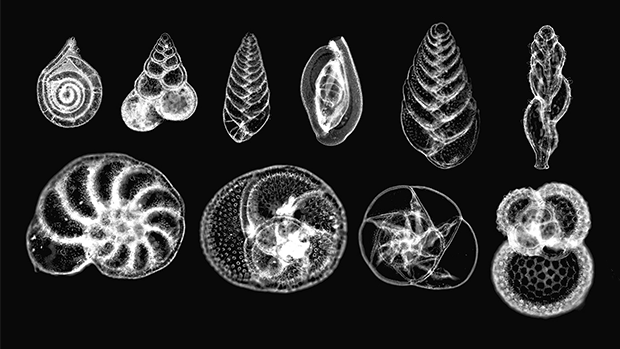
The exact mechanisms that control the creation of shells are still not properly known. Scientists think that the animal secretes certain proteins which bind calcium ions and direct the formation of either calcite or aragonite crystals, with different proteins mediating formation of the different minerals.
BUILDING AN ENVIRONMENTAL RECORD OVER TIME
As the animal grows, its home—the protective shell that surrounds it—must get bigger, and so they grow their shells layer upon layer, creating ‘growth-bands’, or growth increments, within the shell. Some of these growth increments are visible on the external surface of the shell, while others are only visible in the internal structure. But the interesting thing about the growth increments is that their width, or thickness, is affected by environmental conditions, like temperature. Some growth increments are a reflection of tidal cycles, some show annual periodicity. So the series of growth increments within a shell are essentially a record of the animal’s lifetime and, similar to the study of tree-rings, some scientists study them to make interpretations about the environment where that animal lived and grew.
The chemical characteristics are significant too—other metals, like magnesium (Mg2+) or strontium (Sr2+) can substitute for the calcium in the calcium carbonate, and this often depends on environmental conditions like temperature or salinity. Heavy metals incorporated into the shell can provide a record of environmental contamination or pollution. So just spare a thought about the environmental record preserved in the shell layers of the next oyster or scallop you eat at a seafood buffet!
All different shapes…
There are lots of different species of snails and shellfish, so it stands to reason that there are lots of different shapes and sizes of shells! Most of the shells you’ll encounter when wandering on the beach are either bivalves—shells made of two (often symmetrical, but not always) valves, like mussels, clams, scallops and pipis. Others are gastropods—the snail-shaped ones, like limpets, periwinkles, whelks and cowries.
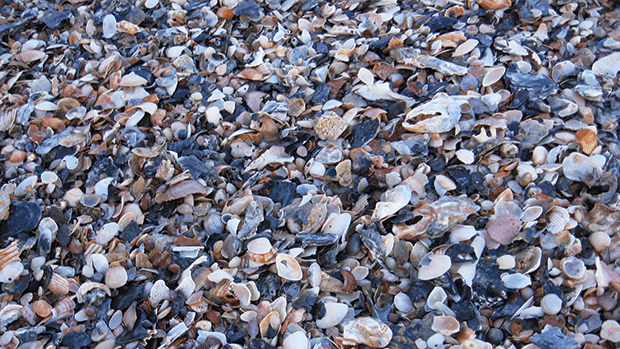
One of the archetypal shell structures is the graceful spiral created by many gastropods. These shells generally consist of chambers in which the animal lives. As the animal grows, it needs a bigger chamber, and so it adds a new one onto the shell.
Shell spirals have an elegant geometry, where for any rotation angle, the distance from the origin of the spiral increases by a fixed amount. This is known as a logarithmic spiral. The other interesting thing about spiral shells is that the vast majority of them rotate to the right—they are dextral. Sinistral shells, whose spirals rotate to the left, are very rare. This hasn’t always been the case—the fossil record shows that the predominant direction of spiral shells has swapped back and forth throughout geological time.
COLOURS
As for the stripes that were on my little googly-eyed shell friend, most shell colourings are caused by pigments incorporated into the calcium carbonate shell, or within the periostracum. Usually the pigments are incorporated in a regular pattern, such as stripes or spirals of colour. In other shells, it’s not so regular, with spotty or splotchy colourings.
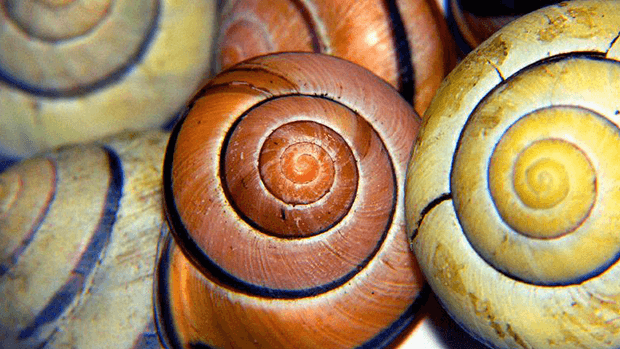
As to why, there are a few explanations. It’s thought that tropical shells are more varied and colourful as a result of the greater diversity of food sources available to them as compared to their cold water counterparts, which generally exhibit darker, duller colours. Some colourings work extremely well as camouflage, allowing the animal to blend in with its surroundings and hide from predators. Some shells, like pipis found along the edge of the beach among the breaking waves, show large amounts of variations in their colours, similar to the variety seen in a beach strewn with pebbles. Some scientists also think that some shell markings act as a sort of guide to the animal for further shell growth.
But this doesn’t really explain all the variation we see in some shells’ colours—some shells live in the deep ocean, where the darkness makes a visual camouflage somewhat redundant. And the colouring seen in some shells, such as the deep purple of a mussel, are only on the inside of the shell, visible only after the animal has died.
… and sizes
Shell size can in part be related to the environment where it grows. Some (but not all!) shellfish from colder regions, closer to the poles, are very slow-growing, and so don’t grow very big. They can, however, live for a long time—the oldest known individual animal is actually a shellfish—the ocean quahog, Arctica islandica. This shellfish lives in the cold waters of the north Atlantic, and the growth banding of one shell sample showed that it lived to be 507 years old.
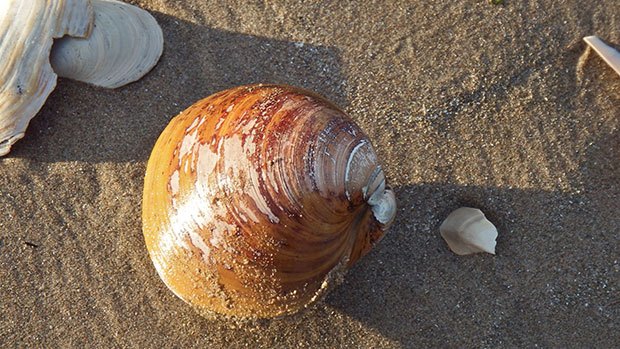
Warm, tropical locations are home to giant clams (Tridacna spp.)—which can reach more than 1.2 metres in size—and also to the tiny shells that help make up the sand on some beaches on coral atoll islands. The tiniest mollusc shell is that of a snail that lives on limestone cliffs in Malaysian Borneo—it has an average height of 0.7 millimetres.
Speaking of tiny, it would be remiss to overlook the huge range of microorganisms that live in the ocean that also build shells of calcium carbonate. These are the foraminifera (affectionately known as forams) and are present in ocean sediments, the ocean water column and other aquatic environments. All in all, there are over 50,000 foram species—10,000 living and another 40,000 documented within the fossil record. Of the living species, only around 40 species live within the water column and the rest live within the sediments of the sea (or lake, or river) bed. Although these animals are tiny, they also build extremely elaborate and beautifully structured shells, and they play a crucial role in cycling carbon through the planet’s oceans.
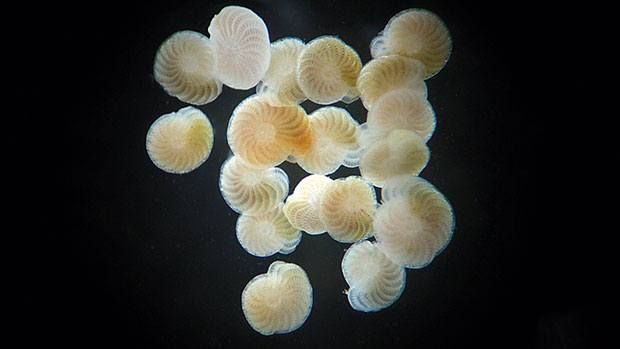
Another important shell-maker in the ocean that is extremely important to the global carbon cycle are coccolithophores. These guys are actually single-celled plants. They are also microscopic, and are formed from several circular ‘plates’ layered over each other to form a spherical shape. Individual plates are around three one-thousandths of a millimetre in diameter. There is a ridiculous amount of coccolithophores in the ocean—there can be two generations produced in a single day and it’s estimated these tiny creatures create more than 1.4 billion kilograms of calcite per year.
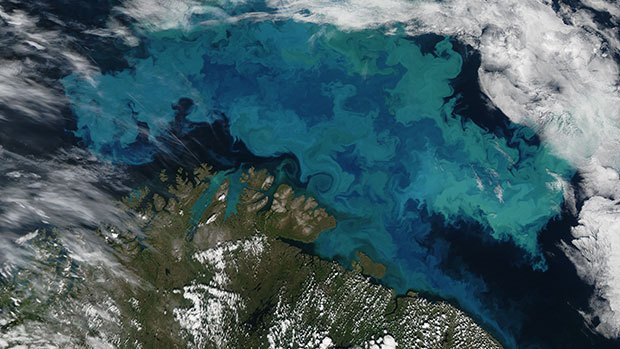
And to complete the trifecta of tiny, we have ostracods. These are tiny crustaceans that also form a calcite shell. There are around 70,000 known species of ostracods, 13,000 of which are still living, the others found only in the fossil record. Ostracods are found in both marine and freshwater environments.
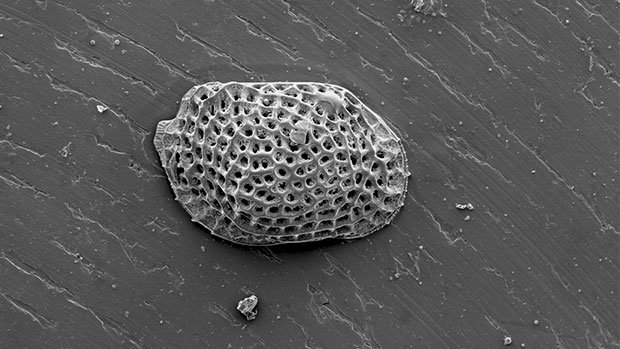
Just as bigger shells can record environmental conditions in the structure and chemistry of their shells, so do foraminfera, coccolithophores and ostracods. Specimens preserved throughout the fossil record have provided a wealth of information that scientists have used to determine Earth’s climatic conditions in the far distant past. It was by studying the chemistry of forams that scientists were able to put together the Earth’s history of glacial cycles (Ice Ages)—tiny shells that told a huge story.
Other shells that are important in the fossil record are brachiopods. There are still some species of brachiopods that exist today, but not many—they have largely been out-competed through geological history by the mollusc species that are common today. They are extensive in the fossil record though, and their shells can also provide important climate information.
And although it’s these beautiful, intricate shells, replete with information, that are the legacy these animals leave behind, shellfish animals themselves have played an important role in human history and evolution. Shellfish have been an important part of the Hominin diet for more than a million years. Homo erectus in Trinil, Java, H. erectus in the Levant at Ubeidiya, Neanderthals in Gibraltar and early H. sapiens at Pinacle Point in South Africa all feasted on seafood buffets back in the day. It’s thought that the micronutrients (e.g. Omega 3s/DHAs) from these foods likely played an important role in brain evolution. So we can thank shellfish for not only providing a record of climatic history within their shells, but also for enabling us to be smart enough to figure it out!
All in all, the diversity in size, shape and colouring of the shells is nothing short of amazing, and quite a few mysteries remain regarding the mechanics of exactly how these animals create their strong, lightweight and durable homes.






